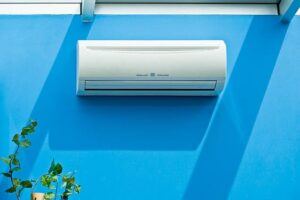Ducted reverse cycle air conditioning offers complete climate control for your home. They are energy efficient and add value to your property in the long term.
The indoor unit of a ducted air conditioner is usually located in the roof cavity with multiple ducts running from it to different rooms in your house (known as ‘zones’). Zone control allows you to choose which zones to cool and heat – saving energy usage in areas that aren’t being used. For more information about reverse cycle ducted air conditioners, click here.
Cost
 As ducted air conditioning is centrally controlled, it can heat and cool an entire property quickly and efficiently. It also uses very little energy compared to other power-driven air conditioners.
As ducted air conditioning is centrally controlled, it can heat and cool an entire property quickly and efficiently. It also uses very little energy compared to other power-driven air conditioners.
The upfront cost of a ducted system will depend on a few factors. One of the most important is the size of your property. This determines how many ducts and vent grilles will be required for installation. The more ducts and vents the system operates through, the higher the installation costs.
Another factor is the amount of insulation installed in your home. A poorly insulated property can lead to excessive heating or cooling bills due to escaping thermal energy.
Noise
As the name suggests, reverse cycle air conditioning offers heating and cooling from one unit. This means you’ll have greater efficiency and save on running costs.
The system works by extracting heat from the air and pumping it outside to cool it to a comfortable temperature. This is up to 3x more efficient than fan or evaporative systems. For more information about reverse cycle ducted air conditioners, click here.
No air conditioner can be silent, but many can achieve whisper-quiet performance. Ducted systems are quiet, with conditioned air expelled through sleek outlets rather than prominent indoor units.
This is usually a bad sign if you hear buzzing, rattling, or grinding from your ducted air conditioning. It indicates that the fan motor or dual shaft bearing is starting to wear out. This is a severe problem that will require immediate attention. Contact a qualified technician as soon as possible. They can repair or replace the fan belt to prevent further damage.
Zoning
With zoning, it’s possible to cool your house in different areas depending on how the room is used. For example, you can cool your living area during the day and bedrooms at night. This saves energy by not cooling areas that aren’t needed.
However, if you have a large amount of natural light in a zone, it may be more challenging for the system to reach a comfortable temperature. This is because natural light increases the heat an area can absorb.
This can cause the air conditioner to work harder and increase operating costs. To solve this problem, you can install thermal insulation in the ceilings and walls of rooms with a lot of natural light. Fortunately, this is relatively easy to do and can reduce electricity bills. It is also worth installing a ceiling fan in any zone with a lot of natural light, as this will help spread the heat more evenly.
Energy efficiency
While you will pay an initial investment in a reverse-cycle air conditioner, it pays off handsomely over time. This is due to the efficiency of these systems. For more information about reverse cycle ducted air conditioners, click here.
Unlike split system air conditioning, which is focused on one room, a ducted system uses a series of insulated ducts to distribute warm or cool air to your entire home. They are designed to run quietly and with minimal energy use.
Reverse-cycle ducted air conditioning is energy efficient because it works in four phases of the refrigeration cycle:
The evaporator absorbs heat from indoor air and converts it into liquid refrigerant. The refrigerant is pumped to the compressor, which pumps it into a high-temperature, high-pressure gas state.
From here, the refrigerant goes through a cooling process that allows it to liquefy, which in turn absorbs heat from the evaporator again and repeats the cycle. The zoning feature of this system also saves energy by heating or cooling only the areas you want.
